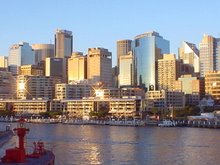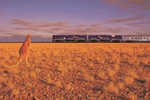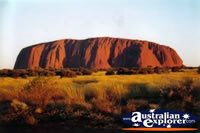Our campground in Denmark is on the Wilson Inlet. Here’s a morning picture. (One thing I should note now so I don’t forget it is that on all four nights in campgrounds we found cheerful, chipper folks on the registration desk.)

In the morning we drive west to the Walpole Normalup National Park, home to the Tree-Top Walk. All along Dick’s been scouting for wildlife. He thought he saw a kangaroo, but by the time we could park on the shoulder and walk back, it was gone, if indeed that’s what it was. A school-bus driver passing by and stopped to see if we needed help. Said he thought maybe we had hit a kangaroo, so we were in their territory.
Another thing we’ve been looking for is the Southern Cross – the star formation that ocean navigators use south of the equator. Couldn’t find it before turning in, but when I got up about 3am for relief I think I saw it. Didn’t have my glasses on so can’t be sure. Should have gotten Dick up to confirm the sighting.
At any rate, we got to the National Park before the gates opened so we went exploring down a side road, looking for ‘roos. Here’s the only one we found. Later in the day we saw two road-kill ‘roos, but so far that’s it.

Roadside signs promised kangaroos next 20 km, but it never happened.
Here are some pictures of and from the Tree Top Walk. It was a gray sky day with occasional sprinkles. The walkway's highest point is 130 ft. above the forest floor – like being on top of a 13-floor building. The walkway is designed to sway with the breeze, like the treetops. Walkways also are quite springy.
The preservation reason behind the walk is that people walking on the forest floor compact the earth and this damages the big trees’ roots and ability to absorb nutrients. So, for the sake of the trees and as an attraction they put people up in the treetops. Makes it easier on your neck, too.

The big trees are different versions of what they call a “tingle tree.” They’re varieties of eucalyptus trees – there must be dozens of varieties in Australia. The biggest is called a Karri tree. It looks like the big Kauri trees we saw in New Zealand – no doubt related -- but I recall the NZ trees as being larger.

The Tree Top Walk was the main attraction that drew us to this part of the country and we were greatly impressed. Somebody should build one in the USA.
Adjacent to the Walk is another big tree area that you do walk through.

We spent the afternoon driving NW through a lot of forested land and some farmland headed for Margaret River, the center of a region known for wine-making. On the way we stopped at the Cape Leeuwin Lighthouse. The cape is named for a Dutch sailor thought to be the first European in the area – the SW corner of Australia. Looking south, the Indian Ocean is on the right and the Southern Ocean is ahead and to the left. It’s hard to see the dividing line, though.

Here are lighthouse pictures: inside (177 steps; the lighthouse keepers would carry two large buckets of kerosene up these stairs, sidestepping, once a week).

and outside:

Had a very interesting and enthusiastic guide. Last tour of the day and he gave us extra time and info. In the early 1800s England started three settlements in SW Australia – Albany, Augusta (just above Cape Leeuwin), and Perth. This enabled them to claim the whole continent for the Queen (or King as the case may be). I’m conjecturing, but I think having just lost the US colonies, England had the resources available, and motivation, to colonize elsewhere. I mean, they had Canada and not much else, so it’s easy to see why Australia was important to them – Rule, Brittania -- and, ultimately, not just as a dumping ground for prisoners.
Our guide told us that if France had taken this part of Australia it would just have meant getting good wine sooner – a reference to the Margaret River region which has boomed here only over the last 40 years and which is our evening's destination.
We got to Margaret River after dark, spent a lot of time searching for a caravan park – we would follow arrows, but not find a park – and finally found one – another nice owner, I believe, who had just been in MR a few weeks. She pointed us to a spaghetti house for a good dinner.
Cheers,
Rob





No comments:
Post a Comment